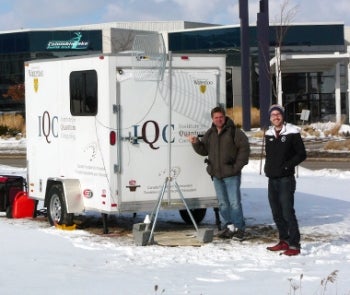
Quantum talk: Moving from the possibility of two people to a network of people
University of Waterloo physicists conduct quantum experiment in trailers on campus to move quantum communication forward

University of Waterloo physicists conduct quantum experiment in trailers on campus to move quantum communication forward
By Jodi Szimanski Institute for Quantum ComputingIn the world of quantum communications, researchers use names like Alice, Bob and Charlie to help them communicate their complex theories. Alice and Bob have been communicating for years. Charlie joined the conversation a few years ago.
 For the first time, physicists at the University of Waterloo’s Institute for Quantum Computing (IQC) have demonstrated the distribution of three entangled photons at three different space-like separated locations (Alice, Bob and Charlie) several hundreds of metres apart.
For the first time, physicists at the University of Waterloo’s Institute for Quantum Computing (IQC) have demonstrated the distribution of three entangled photons at three different space-like separated locations (Alice, Bob and Charlie) several hundreds of metres apart.
“The interesting result is that we now have the ability to do more than paired quantum communication,” said the paper’s lead author Chris Erven, a former IQC PhD student who is now a research assistant at the University of Bristol.
Erven says the experiment broadens the possibilities of quantum communication from two people to a network of people. “This is the first experiment where you can now imagine a network of people connected in different ways using the correlations between three or more photons.”
The findings of the experiment, Experimental Three-Particle Quantum Nonlocality under Strict Locality Conditions, are published in Nature Photonics.
The ability to instantaneously “know” about the other’s state
It is the first time, researchers have shown what is called quantum nonlocality for more than two entangled photons.
Quantum entanglement is a phenomenon of quantum mechanics where an extremely strong correlation exists between quantum particles. These quantum systems cannot be described independently of each other despite the distance separating them. This disregards what Einstein called the "principle of local action," the rule that distant objects cannot have direct influence on one another, and that an object is directly influenced only by its immediate surroundings. By measuring these correlations, the scientists were able to demonstrate this quantum nonlocality, the ability of the particles to instantaneously “know” about each other’s state, even when separated by these large distances.
Using trailers parked in fields to do quantum experiments
To truly test that the hidden local variables are not responsible for the correlation between the three photons, IQC scientists needed the experiment to close what is known as the locality loophole. They achieved this separation of the entangled photons in a way that did not allow for a signal to coordinate the behaviour of the photons, by beaming the entangled photons to trailers parked in fields several hundred meters from their lab.
“Correlations measured from quantum systems can tell us a lot about nature at the most fundamental level,” said co-author Professor Kevin Resch, Canada Research Chair in Optical Quantum Technologies and recent winner of the E.W.R. Steacie Fellowship from the Natural Sciences and Engineering Research Council of Canada (NSERC). “Three-particle entanglement is more complex than that of pairs. We can exploit the complex behaviour to rule out certain descriptions of nature or as a resource for new quantum technologies.”
The project team studied the correlations of three photons in a Greenberger-Horne-Zeilinger (GHZ) state – a type of entangled quantum state involving at least three particles.
Photon triplets generated in IQC lab
First, photon triplets were generated in Resch’s lab – the Alice in the experiment. Then, the first photon was delayed in a 580m optical fibre in the lab while the two other photons travelled up 85m of optical fibre to the rooftop where they were sent through two telescopes. Both photons were then sent to two trailers, Bob and Charlie, about 700m away from the source and from each other.
To maintain the space-like separation in the experiment, a fourth party, Randy, located in a third trailer randomly selected each of the measurements that Alice was to perform on her photons in the lab.
Each trailer contained detectors, time-tagging devices developed by IQC spin off company Universal Quantum Devices (UQD), and quantum random number generators. To ensure the locality loophole was closed, the random number generators determined how the photon at each trailer would be measured independently. The UQD time tagging devices also ensured the measurements happened in a very small time window (three nanoseconds), meaning that no information could possibly be transmitted from one location to the other during the measurement period – a critical condition to prove the non-locality of entanglement.
“The idea of entangling three photons has been around for a long time,” said Professor Thomas Jennewein, a co-author of the paper. “It took the right people with the right knowledge to come together to make the experiment happen in the short time it did. IQC had the right mix at the right time.”

Read more
The awarded proposal seeks to understand and mitigate the loss of quantum information

Read more
Scientists recreate properties of light in neutral fundamental particles called neutrons

Read more
A new imaging technique using quantum science may lead to novel drug therapies and treatment options, a recent study has found.
The University of Waterloo acknowledges that much of our work takes place on the traditional territory of the Neutral, Anishinaabeg, and Haudenosaunee peoples. Our main campus is situated on the Haldimand Tract, the land granted to the Six Nations that includes six miles on each side of the Grand River. Our active work toward reconciliation takes place across our campuses through research, learning, teaching, and community building, and is co-ordinated within the Office of Indigenous Relations.